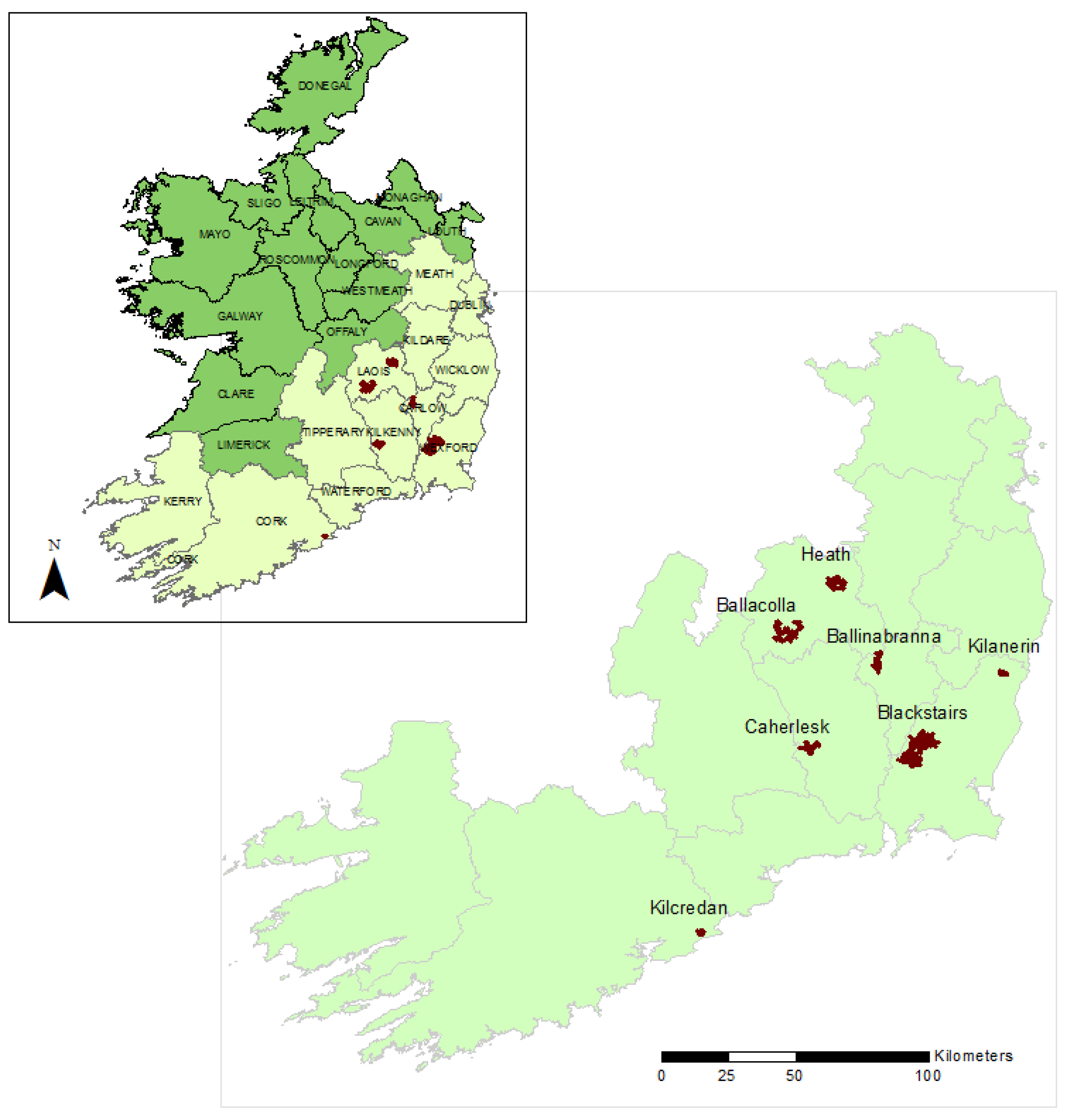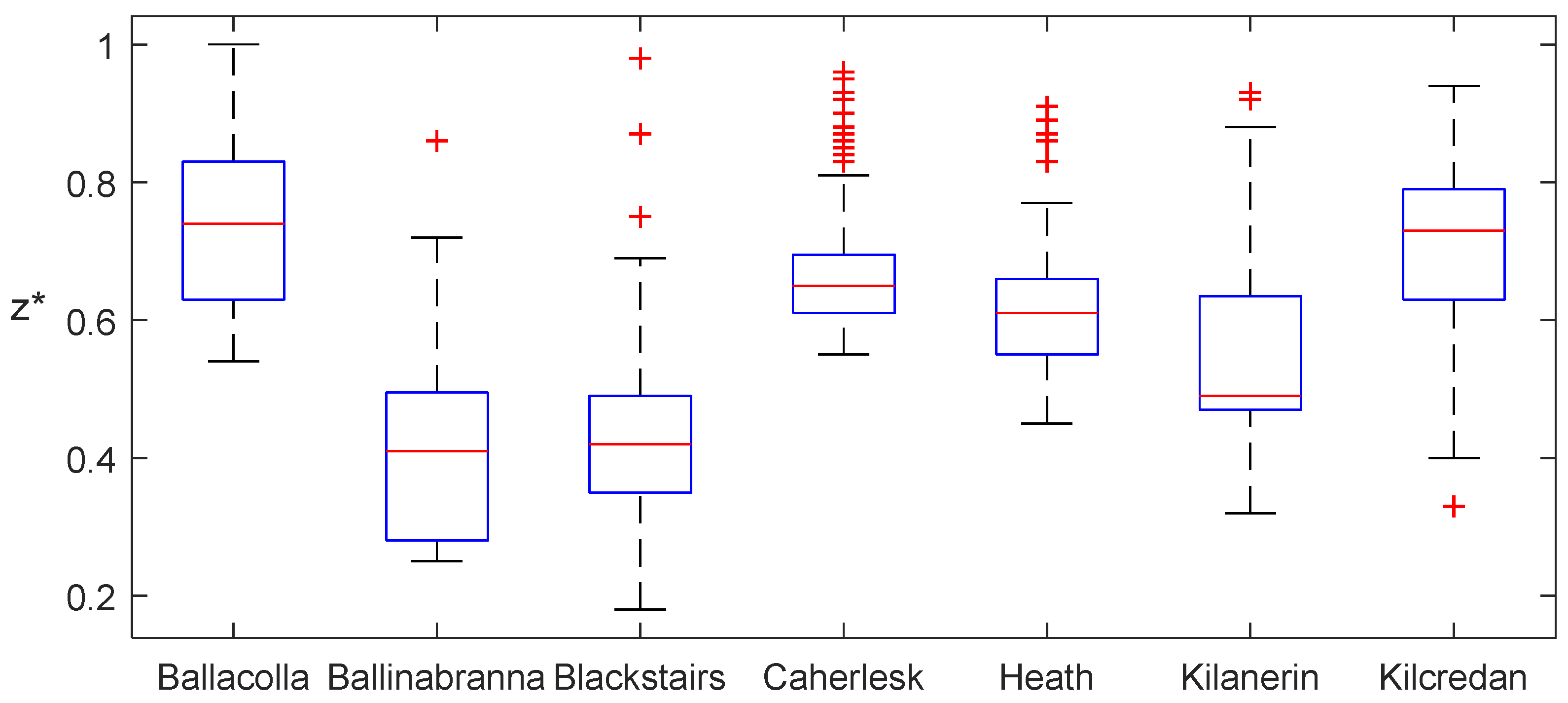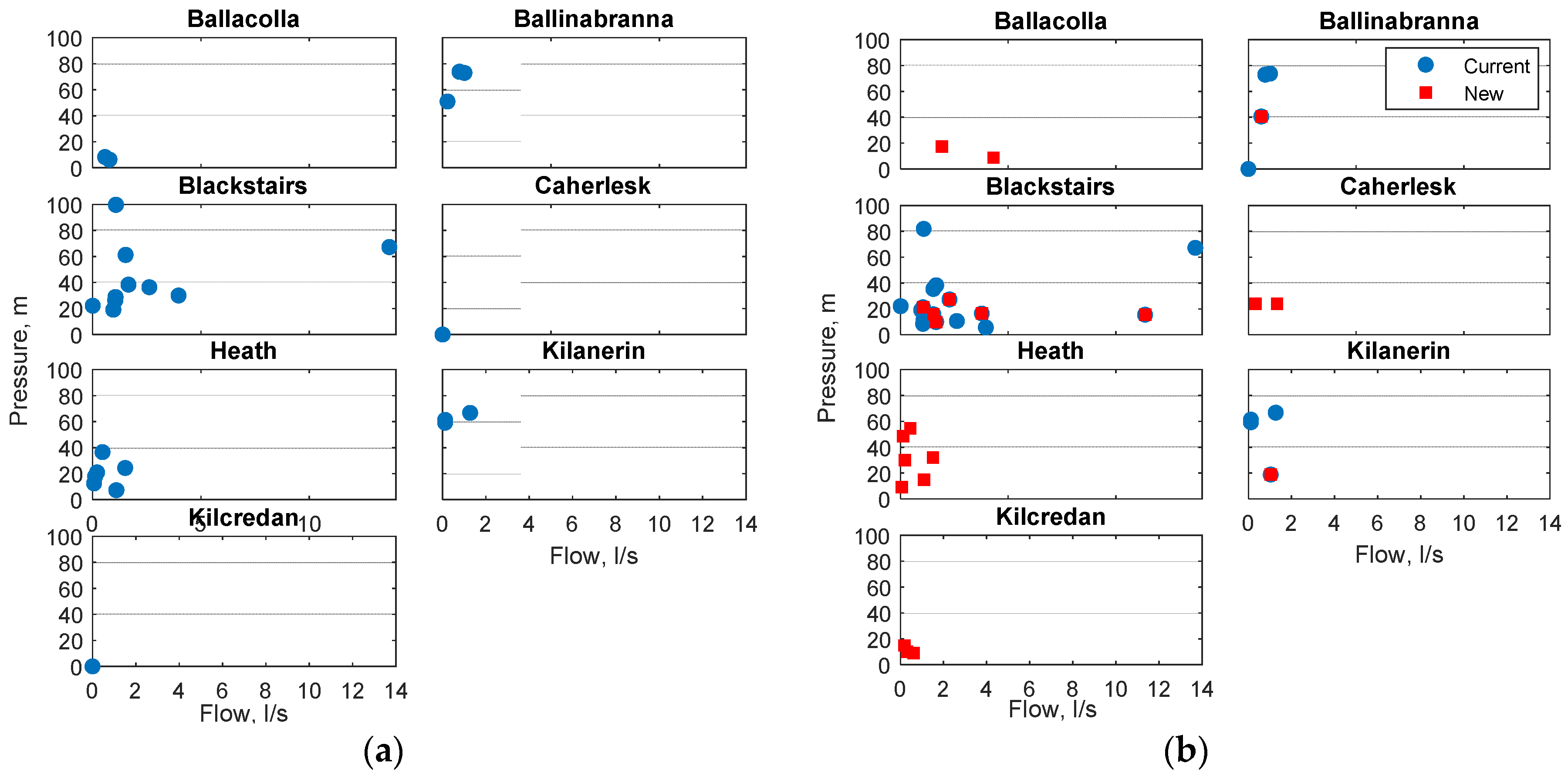Potential Micro-Hydropower Generation in Community-Owned Rural Water Supply Networks in Ireland †
Abstract
:1. Introduction
2. Methodology
2.1. Case Study
2.2. Problem Approach
- Scenario 1: This scenario consisted of the evaluation of MHP potential by replacing the current PRVs or BPTs with a PAT, where applicable. The actual pressure drop in each pressure reducing element was used to calculate the hydraulic head at the PAT.
- Scenario 2: In this case, new reduced pressure settings or new potential locations for the installation of PATs were proposed, always ensuring the minimum flow-pressure require ments at each consumption node. The potential locations were selected considering both the node elevation and the flow.
2.3. Hydropower Potential Estimation by the Elevation Dimensionless Coordinate
2.4. Hydropower Potential Indicator
2.5. Estimation of Water and Cost Saving by Leakage Reduction
2.6. Economic Analysis
3. Results and Discussion
3.1. Elevation Dimensionless Coordinate
3.2. Potential Micro-Hydropower in the CORWSNs
- Scenario 1.
- Scenario 2.
4. Conclusions
Author Contributions
Acknowledgments
Conflicts of Interest
References
- IEA (International Energy Agency). Water Energy Nexus-Excerpt from the World Energy Outlook 2016. Available online: https://www.iea.org/publications/freepublications/publication/WorldEnergyOutlook2016ExcerptWaterEnergyNexus.pdf (accessed on 22 January 2018).
- Gallagher, J.; Harris, I.M.; Packwood, A.J.; McNabola, A.; Williams, A.P. A strategic assessment of micro-hydropower in the UK and Irish water industry: Identifying technical and economic constraints. Renew. Energy 2015, 81, 808–815. [Google Scholar] [CrossRef]
- Corcoran, L.; Mcnabola, A.; Coughlan, P. Optimization of Water Distribution Networks for Combined Hydropower Energy Recovery and Leakage Reduction. J. Water Resour. Plan. Manag. 2015, 142, 1–8. [Google Scholar] [CrossRef]
- Fecarotta, O.; McNabola, A. Optimal Location of Pump as Turbines (PATs) in Water Distribution Networks to Recover Energy and Reduce Leakage. Water Resour. Manag. 2017, 31, 5043–5059. [Google Scholar] [CrossRef]
- Tricarico, C.; Morley, M.S.; Gargano, R.; Kapelan, Z.; Savić, D.; Santopietro, S.; Granata, F.; de Marinis, G. Optimal energy recovery by means of pumps as turbines (PATs) for improved WDS management. Water Sci. Technol. Water Supply 2017. [Google Scholar] [CrossRef]
- Ramos, H.; Borga, A. Pumps as turbines: An unconventional solution to energy production. Urban Water 1999, 1, 261–263. [Google Scholar] [CrossRef]
- NFGWS National Federation of Group Water Schemes. Annual Report 2016. Available online: http://www.nfgws.ie/f//2016 Annual Report.pdf (accessed on 23 January 2018).
- Rossman, L. EPANET 2. Users Manual; US Environmental Protection Agency (EPA): Washington, DC, USA, 2000. [Google Scholar]
- Araujo, L.S.; Ramos, H.; Coelho, S.T. Pressure Control for Leakage Minimisation in Water Distribution Systems Management. Water Resour. Manag. 2006, 20, 133–149. [Google Scholar] [CrossRef]
- Goldberg, D.E. Genetic Algorithms in Search, Optimization, and Machine Learning; Addison-Wesley Longman Publishing Co., Inc.: Chicago, IL, USA, 1989; ISBN 0201157675. [Google Scholar]
- SEAI Electricity & Gas Prices in Ireland. 1st Semester (January–June) 2017. Available online: https://www.seai.ie/resources/publications/Electricity_Gas_Prices_January_June_2017 (accessed on 10 May 2018).
- Novara, D.; McNabola, A. The development of a decision support software for the design of Micro-Hydropower schemes utilizing a Pump as Turbine. In Proceedings of the 3rd EWaS International Conference on “Insights on the Water-Energy-Food Nexus”, Lefkada, Greece, 27–30 June 2018. [Google Scholar]





| Average Flow (L s−1) | Consumption Nodes | Head (m) | Node Elevation, Min (m a.s.l.) | Node Elevation, Max (m a.s.l.) | PRV (Number) | BPT (Number) | |
|---|---|---|---|---|---|---|---|
| Ballacolla | 7.03 | 49 | 145 | 79 | 145 | 2 | 0 |
| Ballinabranna | 2.02 | 44 | 190 | 47 | 164 | 3 | 0 |
| Blackstairs | 13.76 | 122 | 277 | 51 | 271 | 3 | 8 |
| Caherlesk | 2.40 | 150 | 120 | 66 | 115 | 0 | 0 |
| Heath | 3.07 | 70 | 180 | 81 | 164 | 6 | 0 |
| Kilanerin | 1.76 | 27 | 190 | 60 | 176 | 2 | 1 |
| Kilcredan | 1.70 | 45 | 87 | 29 | 82 | 0 | 0 |
Publisher’s Note: MDPI stays neutral with regard to jurisdictional claims in published maps and institutional affiliations. |
© 2018 by the authors. Licensee MDPI, Basel, Switzerland. This article is an open access article distributed under the terms and conditions of the Creative Commons Attribution (CC BY) license (https://creativecommons.org/licenses/by/4.0/).
Share and Cite
García, I.F.; Ferras, D.; McNabola, A. Potential Micro-Hydropower Generation in Community-Owned Rural Water Supply Networks in Ireland. Proceedings 2018, 2, 677. https://doi.org/10.3390/proceedings2110677
García IF, Ferras D, McNabola A. Potential Micro-Hydropower Generation in Community-Owned Rural Water Supply Networks in Ireland. Proceedings. 2018; 2(11):677. https://doi.org/10.3390/proceedings2110677
Chicago/Turabian StyleGarcía, Irene Fernández, David Ferras, and Aonghus McNabola. 2018. "Potential Micro-Hydropower Generation in Community-Owned Rural Water Supply Networks in Ireland" Proceedings 2, no. 11: 677. https://doi.org/10.3390/proceedings2110677





